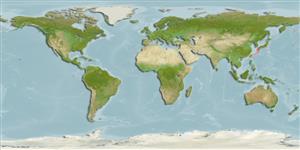>
Aulopiformes (Grinners) >
Paraulopidae (Cucumber fishes)
Etymology: Paraulopus: Paraulopus refers to a taxon related to Aulopus, both being included in the Aulopiformes.
Environment: milieu / climate zone / depth range / distribution range
Écologie
marin bathydémersal; profondeur 322 - 375 m (Ref. 49923). Deep-water
Northwest Pacific: Kyushu-Palau Ridge and the Emperor Seamounts.
Taille / Poids / Âge
Maturity: Lm ? range ? - ? cm
Max length : 12.5 cm SL mâle / non sexé; (Ref. 49923)
Description synthétique
Clés d'identification | Morphologie | Morphométrie
Épines dorsales (Total) : 0; Rayons mous dorsaux (Total) : 11; Épines anales: 0; Rayons mous anaux: 8 - 10; Vertèbres: 42 - 44. Second and third dorsal fin rays very elongated, prolonged filamentously, extending when depressed well beyond adipose fin in males, not quite reaching adipose fin in females (Ref. 49923). Sexually dimorphic in dorsal and caudal fin coloration: dorsal fin with a black upper margin broader in males than in females; caudal fin white with a black posterior margin on each lobe in males, black margin absent in females (Ref. 49923).
Life cycle and mating behavior
Maturité | Reproduction | Frai | Œufs | Fécondité | Larves
Sato, T. and T. Nakabo, 2003. A revision of the Paraulopus oblongus group (Aulopiformes: Paraulopidae) with description of a new species. Ichthyol. Res. 50(2):164-177. (Ref. 49923)
Statut dans la liste rouge de l'IUCN (Ref. 130435: Version 2024-1)
Menace pour l'homme
Harmless
Utilisations par l'homme
Outils
Articles particuliers
Télécharger en XML
Sources Internet
Estimates based on models
Phylogenetic diversity index (Ref.
82804): PD
50 = 0.5001 [Uniqueness, from 0.5 = low to 2.0 = high].
Bayesian length-weight: a=0.00389 (0.00180 - 0.00842), b=3.12 (2.94 - 3.30), in cm total length, based on all LWR estimates for this body shape (Ref.
93245).
Niveau trophique (Ref.
69278): 3.8 ±0.7 se; based on size and trophs of closest relatives
Fishing Vulnerability (Ref.
59153): Low vulnerability (10 of 100).
